If you’re looking to give your kitchen a timeless and elegant look, transitioning from tile flooring to wood is a great option. This popular style of transition adds texture and character to the room while blending seamlessly with existing décor. With so many ways to make this transition, it can be hard to know where to start.
Metal Transition Strips
Metal transition strips are a popular choice for transitioning from tile to wood. They provide a sleek, modern look and come in a variety of styles and finishes. Metal strips are highly effective for creating an even, unified transition between two unique types of flooring, making them the perfect choice for those who want to achieve a cohesive look.
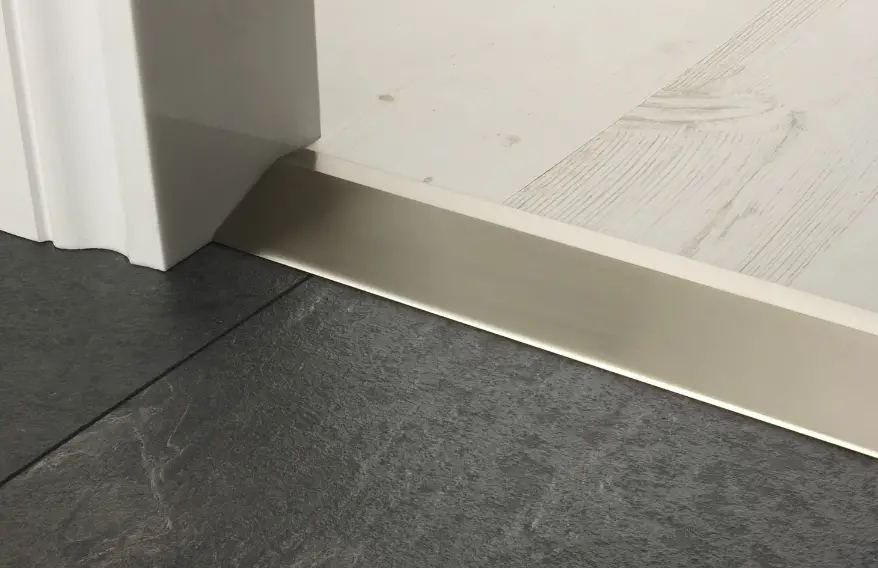
Tile Inlays Create A Dramatic Look
Tile inlays can make for a captivating transition between your tile floor and wood, adding depth to the atmosphere of any room. Inlays are typically custom-made pieces of tile that are placed into the wood flooring to create a decorative border or pattern. Usually, you will have the option to choose different shapes and sizes for your inlaid tiles to make your transition unique.
Additionally, you may be able to pick out different colors or patterns of tile to further customize your look. Unleash your inner creative and make a unique statement with tile inlays – the perfect transition from wood to tile flooring that will captivate everyone who enters!
Customized Geometric Flow Transition
Crafting a personalized geometric transition between your kitchen ceramics and wood flooring is one of the trendiest methods to shift from one material to another. With this technique, you can create a unique design that transitions seamlessly between two materials or keep it simple by choosing tiles and planks with similar yet distinct patterns. The key here is to choose materials that are compatible in terms of color and thickness for a seamless, unified look.
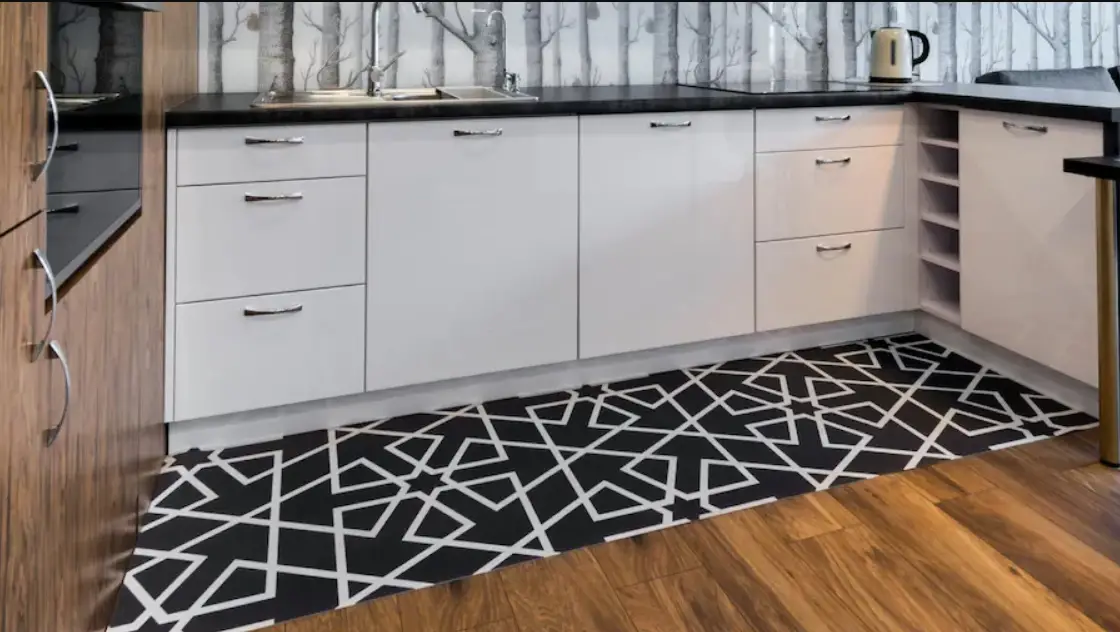
Blending Tiles And Boards Of Equal Size
If you want to make the transition look seamless, use contrasting tiles and boards of equal size. This can be done by using a larger tile combined with a smaller board of similar color and texture, or two tiles of different sizes combined with the same length board. You can also mix up the colors and textures of your tiles to create an interesting effect.
Whatever your choice, make sure that the tiles and boards are lined up perfectly so that the transition looks seamless. To create a more natural look, another alternative is to use an individual tile or board in various sizes. Just make sure that the lines between the tiles and boards don’t clash too much with the rest of your decor. [1]
The End Cap Transition
End cap transition is a highly sought-after technique for moving from kitchen tile to wood flooring. To complete this project, you must cut the last row of tiles at an angle and then affix a piece of wood trim on top. This creates a polished, completed aesthetic that unifies the two materials beautifully.
It also makes it easy to clean as there are no gaps for dirt and debris to accumulate.
When Floors Go Through Doors
For a kitchen tile to wood floor transition, many homeowners opt for a clean and simple look.
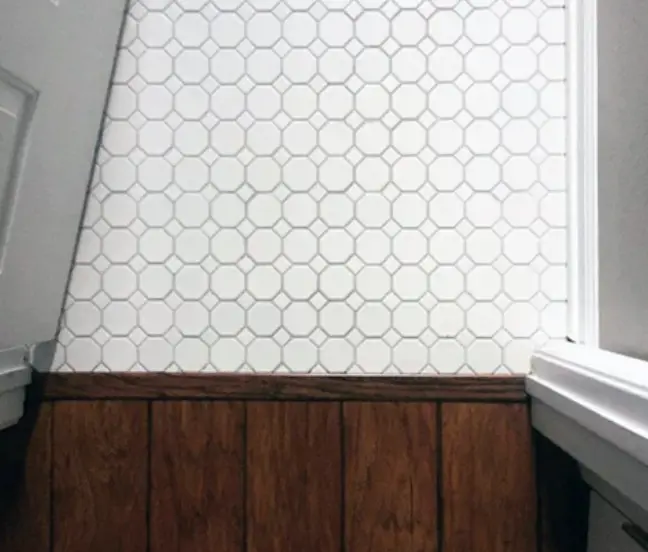
Reducers are the perfect addition to any home, allowing you to seamlessly bridge the gap between kitchen tile and wood flooring. Plus, they are easy to install and can easily be replaced if needed.
A smooth transition from kitchen tile to wood flooring can be achieved with the use of a curved piece, commonly dubbed scotia or ramp. This type of trim creates a smooth, gradual curve between the two surfaces, eliminating the need for a threshold strip. It also provides a more visually interesting and aesthetically pleasing look than a straight transition.
Installing this type of transition can be done in one of two ways.
Tile Or Stone Threshold
A tile or stone threshold is an elegant, classic choice for transitioning from the hard surface of kitchen floor tile to a softer surface such as wood. The threshold should be grouted and sealed with a clear silicone sealant to prevent water damage. A dark colored stone can provide contrast against lighter toned wood floors, while light colors can help blend the two surfaces together.
The tile or stone should be cut to fit the threshold and a pre-mixed thin-set mortar can be used to adhere the stones in place, with grout applied between them for an even look.
For added stability, you may opt to secure the threshold with adhesive caulk or construction adhesive. This type of transition is suitable for both interior and exterior applications. [2]
T-Track Transitions For The Straight And Narrow
Smoothly transitioning from tile to wood flooring is easy when you use the T-track method. This means installing a track of hardwood along the edge of your tiles that transitions into the wood flooring. This works especially well for straight edges, such as in long hallways or when transitioning between different rooms.
The installation process is simple and straightforward, requiring just a few tools and materials. You’ll need hardwood boards, screws, saws, clamps and adhesive to install the T-track transition. To ensure that your transition looks professional, make sure all of your pieces are cut perfectly straight and square before attaching them to the subfloor.
Blending Tiles For A Unique Transition
If you have a unique flooring combination between your kitchen and another room, or if you’re looking for a creative solution to transition from tile to wood, then consider blending tiles.
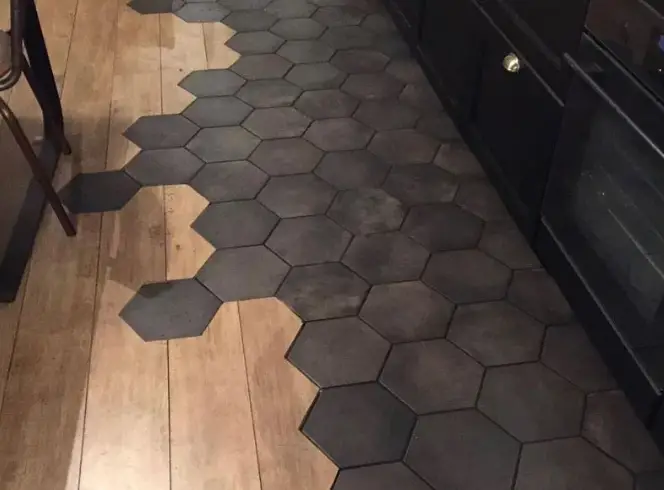
Blending tiles can create an interesting texture as well as add visual interest. It’s also a great way to introduce different colors and patterns that might otherwise be difficult to match.
For example, if you have a tile floor with a variety of patterns and colors, you can choose one or two tiles to create an interesting transition from the kitchen tile to the wood floor.
Alternatively, pick two contrasting tiles that will blend together for a unique look.
Blending tiles is also a great way to add some dimension and texture to your transition without having to worry about pattern matching. Plus, it’s a great way to make the most of any leftover tiles you may have from previous projects.
The Visual Appeal Of Glass Mosaic Tiles
Glass mosaic tiles provide a one-of-a-kind aesthetic when transitioning from tile to wood flooring, adding an interesting and stylish touch. They can be used in many different ways to create a stunning visual effect, from the traditional herringbone pattern to more intricate designs.
The vibrant glass pieces in your home create a captivating contrast with the neutral wooden floors, adding an elegant and visually stunning touch to any room. Whether you choose a plain glass mosaic tile or one with intricate designs and shapes, it will bring your kitchen an added touch of elegance and sophistication.
Not only do these tiles offer attractive aesthetic value for your home, but they are also a practical choice when transitioning from one flooring material to another.
The grout lines between the tiles act as a transition strip, helping to avoid any tripping issues. Glass mosaic tiles are also incredibly durable, so you can enjoy their beauty for years to come. [3]
Pros And Cons Of Switching From Kitchen Tiles To Hardwood Floors
When deciding to switch from kitchen tiles to hardwood floors, it’s important to consider the pros and cons of such a decision. Here are some pros and cons of making the change:
Pros
- Hardwood floors add value to your home. Hardwood floors can increase the resale value of your home, giving you more leverage when selling.
- Hardwood floors are more aesthetically pleasing than tile, adding a touch of luxury to your kitchen.
- Hardwood floors are easier to clean and maintain than tile.
- Not only do hardwood floors add aesthetic value to a home, but they also help purify indoor air as opposed to tiles which can trap dust.
Cons
- Hardwood floors can be more expensive than tile.
- They’re also susceptible to water damage, so they may not be the best choice for areas with heavy foot traffic or in kitchens that get a lot of spills.
- Hardwood floors require regular maintenance, such as sanding and refinishing, which could be costly.
- Installation can also be difficult and time consuming.
Tips For Seamless Floor Transition Ideas
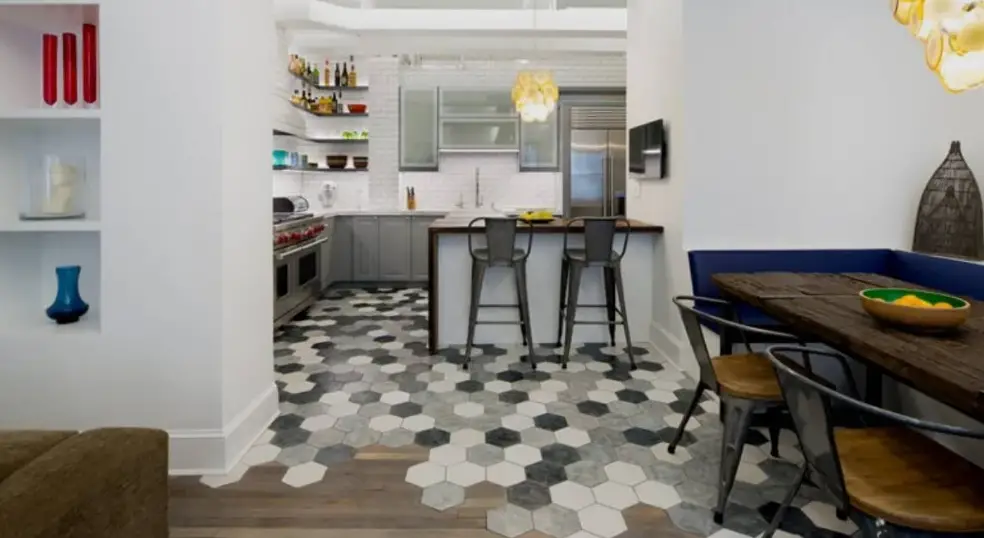
Transitions between one floor and another can be tricky, but it doesn’t have to be. Here are some tips for making a smooth transition from kitchen tile to wood flooring:
Choose compatible materials: Make sure the new wood floor matches with the tile in terms of color, texture, and style. A good transition requires a consistent look and feel between the two materials.
Make sure it’s level: Make sure your subfloor is leveled before installing the wood flooring, or else you may end up with an uneven transition line.
Use matching trim: A matching trim can easily hide any gap or visible transition line between the tile and wood.
Installing a transition strip: An ideal way to ensure a seamless transition is by utilizing a transition strip. Transition strips provide protection against damage and wear, while also creating an attractive look.
Use a border treatment: Borders are often used to separate one type of material from another, and they work great for transitioning from tile to wood. Make sure to pick a border design that will coordinate both the tile and wood flooring for an aesthetically pleasing look. [4]
FAQ
What are the best transitions from tile to hardwood?
The best transitions from tile to hardwood floors depend on the look and feel you are going for in your space. If you want a more classic, seamless look then you could opt for a transition strip or end molding which can help blend the two different floor materials together while also providing a smooth transition between them. Alternatively, if you’re looking for something more modern, then you could choose to do a stepped transition.
This would involve creating two or three steps between the two floors, with each step slightly increasing in height, so that the transition is visible but still looks polished and intentional.
Another popular option is an overlap transition which involves cutting pieces of wood to fit over the tiles and creating a flush transition between the two surfaces. This is a great option for creating a unique, statement-making look in your space.
What kind of flooring looks good next to hardwood?
If you’re looking to give your kitchen a facelift without spending too much money, transitioning from tile to hardwood can be an affordable and stylish way to go. When done correctly, the two flooring types often look stunning when placed together. Establishing a boundary is one of the easiest and most efficient ways to transition from one space to another.
By installing a tile border that frames the hardwood, you can create an aesthetically pleasing transition. Integrate two distinctive wood floorings to make a seamless blend of the two materials.
This allows for more variety and can give your kitchen a unique look. Other options include adding a decorative strip between the two floors or transitioning from tile to wood using a curved edge. Whichever direction you decide to go, making sure the two materials complement each other is key for creating a seamless transition.
What do you put between tile and wood?
To create a seamless transition from tile to wood floors, the ideal choice is a versatile and reliable transition strip. A transition strip is a slender material piece that serves as the link between two distinct flooring materials. Transition strips come in a variety of material and style options, including metal, wood, vinyl, laminate, and more.
They can also be customized to match the color and style of your existing tile floor. Installed transition strips form a nearly invisible boundary between two distinct flooring materials, thus blocking the buildup of dirt, dust particles and any other unwelcome debris.
Moreover, transition strips can make a room appear more attractive by giving an unbroken shift from one flooring material to the next. Prior to selecting a transition strip, take into account the weight and thickness of your tile floor in addition to the type of wood floor that you will be transitioning from.
What can I use instead of transition strips?
If you’re looking for a superior substitute to transition strips, opt for the flush mount transition instead. Cutting a gap between two materials, such as tile and wood, and installing a flush mount transition piece is the key to completing this task.
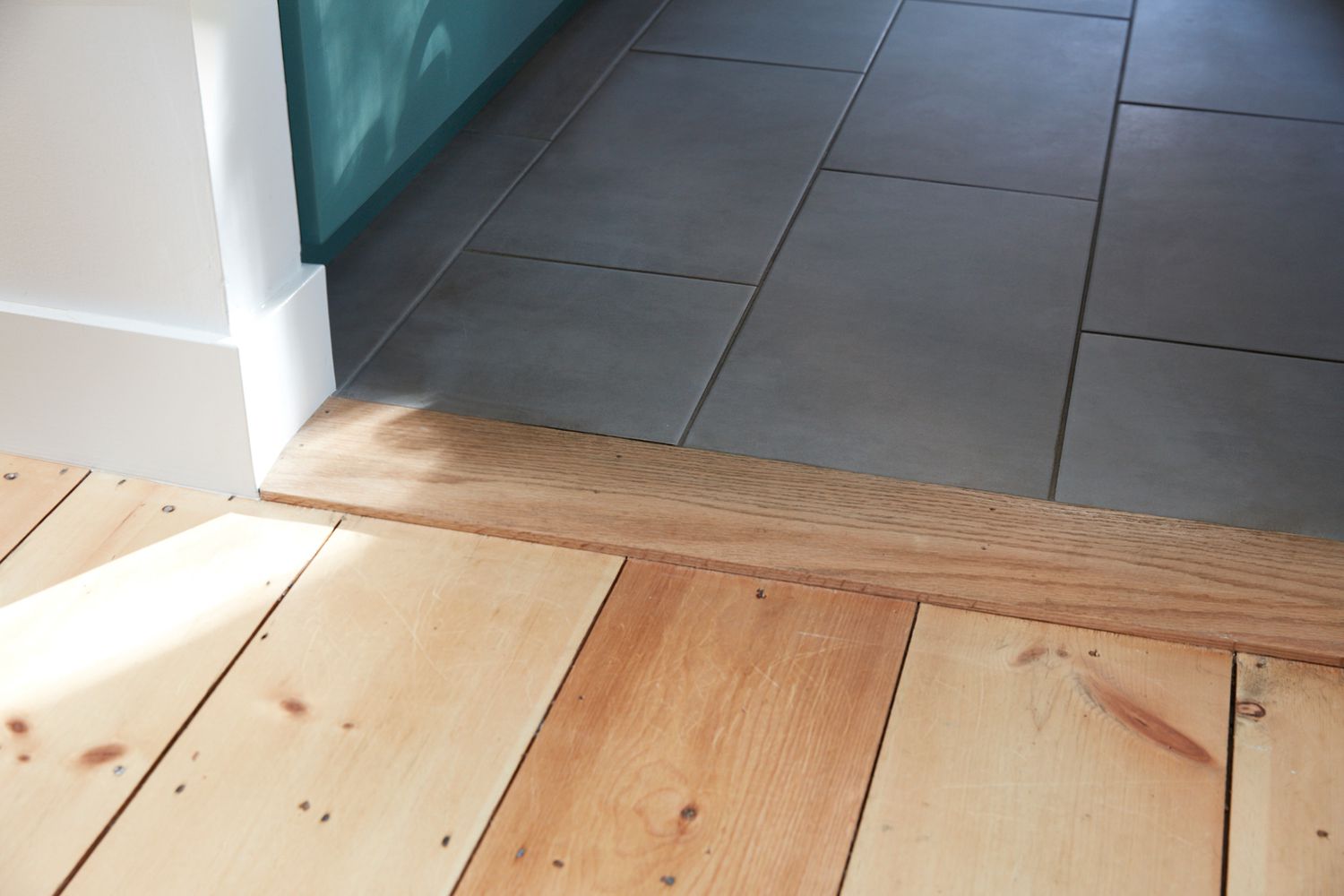
With this, there is an aesthetically pleasing, smooth transition between the two surfaces for a beautiful overall look. Another great alternative is to use a grout line transition.
This involves cutting the tile and wood to fit together from a side view, and then adding a grout line to the top of the transition. This will help create a more blended transition look and make it easier to clean around the edges.
Do you need a transition strip between hardwood and tile?
The short answer is yes. Transition strips are essential in protecting the edges of flooring types and preventing any potential damage either caused by movement or water exposure. Not only do they help create a seamless transition between the two surfaces, but they also make your floor look more cohesive and visually appealing. Also, transition strips can help reduce noise from foot traffic and act as a shock absorber should you drop something on the floor.
What are the thresholds between tile and hardwood?
Thresholds are often referred to as transitions and serve the purpose of creating a seamless transition between two different flooring materials. For an even transition between hardwood floors and tile, a strip of material can be utilized to bridge the two different types of flooring.
The most common type of threshold used for this purpose is a metal or wooden strip, but there are actually several other materials available as well.
Can you mix tile and hardwood floors?
Yes, it is possible to mix tile and hardwood floors in your home. If you’re looking for a fluid and aesthetically pleasing way to bridge the gap between your kitchen and living room, there are countless ways to create an effortless transition. One of the most popular options for mixing tile and wood flooring is using a tiled threshold.
This transition can be used to visually separate the two floorings while making it easy to move between them. Other popular options include creating a border or inlay of tile within a hardwood floor, or installing a decorative inset of tile near the threshold. Whatever method you choose, make sure that all materials are properly aligned and sized for an elegant and cohesive look.
With the right combination of materials, you can create an attractive tile to wood floor transition that will bring a sophisticated touch to your space. Finally, keep in mind that you don’t have to limit yourself to just tile and hardwood. Other materials such as natural stone, laminate, or vinyl can also be used to create interesting transitions between rooms.
Where do you start when transitioning to floors?
The direction of your transition from kitchen tile to wood flooring will depend on the configuration of your room. If you have an open concept living area, you may need to decide where the transition should start in order to make a seamless flow between the two different surfaces. Consider factors such as colors, patterns, and textures to create a harmonious look.
When constructing a kitchen with four walls, the transition point between tile and wood will likely be found at the entryway. This is a great opportunity to showcase your creative skills and create a beautiful transition that flows with the rest of the space’s style.
What color flooring is in for 2023?
2023 will be the year for natural, warm tones. Neutral colors such as taupe, sandstone and whites are in demand. Earthy colors like greens, blues and rich browns will also be popular.
Adding a touch of black can give any room an elegant look or bring some drama to classic neutrals. Whatever your style, be sure to choose flooring that works with the overall aesthetic of your home. However, if you’re looking to make a statement, consider adding an accent color like red or yellow for a pop of whimsy.
Adding a tile element can also help to break up the monotony of solid flooring and create visual interest.
Do wood and tile look good together?
Yes, wood and tile can look great together! With the right design elements, you can create a stylish and unified look in your kitchen. Transitioning between two materials like wood and tile adds visual interest to any space, while creating a seamless transition from one floor to another. Here are some ideas for transitioning between wood and tile floors in your kitchen.
Also, consider investing in heavy-duty transition pieces to help prevent damage from foot traffic and moisture.
Useful Video: Hex tile to hardwood floor transition
Conclusion
When it comes to transforming the look and feel of your kitchen, transitioning from tile to wood flooring can be an easy and elegant choice. It’s effortless to design a smooth transition between two separate surfaces, allowing for ample foot traffic and enhancing the aesthetic value of your space. If you long for a standout threshold, an attractive blended transition molding or an inconspicuous integrated transition strip, your ideal kitchen tile to wood floor transition is just waiting to be found. With the right materials and a bit of creativity, you can create a beautiful and stylish space that reflects your taste and style.
References
- https://easiklip.com/blogs/diy-hardwood-floor-blog/10-ideas-about-wood-to-tile-transition
- https://nextluxury.com/home-design/tile-to-wood-floor-transition-ideas/
- https://www.thespruce.com/tile-floor-transition-1821636
- https://sebringdesignbuild.com/floor-transition-ideas/














Leave a Reply